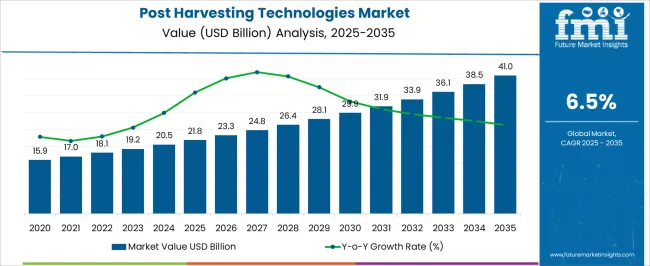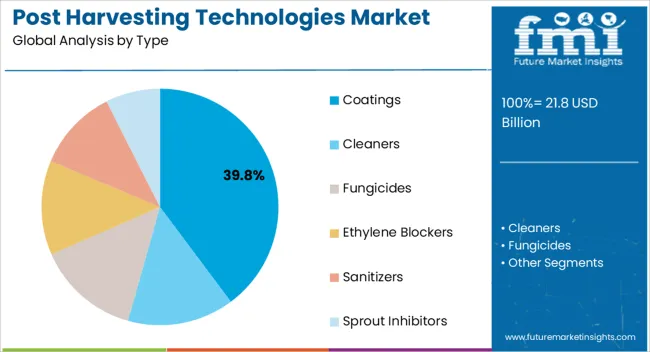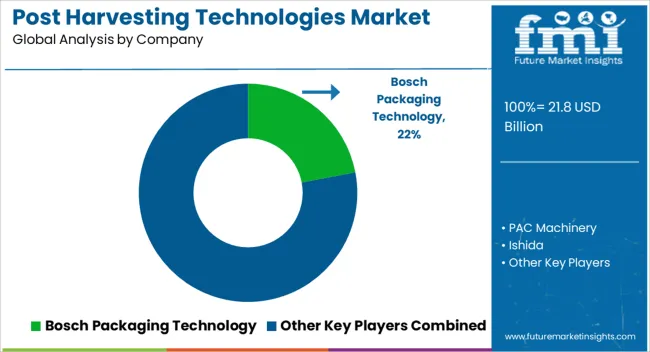The Post Harvesting Technologies Market is estimated to be valued at USD 21.8 billion in 2025 and is projected to reach USD 41.0 billion by 2035, registering a compound annual growth rate (CAGR) of 6.5% over the forecast period.

| Metric | Value |
|---|---|
| Post Harvesting Technologies Market Estimated Value in (2025 E) | USD 21.8 billion |
| Post Harvesting Technologies Market Forecast Value in (2035 F) | USD 41.0 billion |
| Forecast CAGR (2025 to 2035) | 6.5% |
The Post Harvesting Technologies market is witnessing steady expansion due to increasing demand for efficient food preservation solutions across agricultural supply chains. The current market environment is being shaped by the growing need to reduce post harvest losses, particularly in developing regions where storage and handling infrastructure remains inadequate. Rising global awareness about food waste reduction and the demand for longer shelf life are driving investments in advanced preservation technologies.
Growing consumer expectations for high quality and fresh produce are influencing adoption patterns across retail and distribution networks. The integration of innovative solutions that can extend freshness while maintaining nutritional value is being encouraged by both government and private stakeholders. Additionally, regulatory initiatives aimed at improving food safety standards are acting as catalysts for broader acceptance.
The market outlook appears positive, with emerging trends such as sustainable packaging and natural coatings being explored to enhance product quality With global food demand projected to rise, post harvesting technologies are expected to play a key role in ensuring food security and minimizing losses across the supply chain.
The post harvesting technologies market is segmented by type, applications, and geographic regions. By type, post harvesting technologies market is divided into Coatings, Cleaners, Fungicides, Ethylene Blockers, Sanitizers, and Sprout Inhibitors. In terms of applications, post harvesting technologies market is classified into Fruits, Vegetables, and Crops. Regionally, the post harvesting technologies industry is classified into North America, Latin America, Western Europe, Eastern Europe, Balkan & Baltic Countries, Russia & Belarus, Central Asia, East Asia, South Asia & Pacific, and the Middle East & Africa.

The coatings type segment is projected to account for 39.80% of the total Post Harvesting Technologies market revenue in 2025, making it the largest segment by type. This prominence is being attributed to the coatings’ ability to provide an effective barrier that reduces moisture loss, microbial growth, and spoilage. The use of edible and biodegradable coatings has been promoted to meet consumer preferences for safe and natural preservation methods.
The segment’s growth has been further supported by innovations that allow coatings to regulate respiration rates and enhance firmness, which extends the storage life of perishable produce. The increasing demand for chemical-free and sustainable solutions in food handling has also contributed to the preference for coatings.
As retailers and distributors seek efficient methods to reduce shrinkage and maintain product quality, coatings have been adopted widely The segment’s continued expansion is being encouraged by advances in material science and formulation techniques that enhance performance while ensuring compliance with food safety standards.

The fruits application segment is expected to hold 44.70% of the total Post Harvesting Technologies market revenue in 2025, positioning it as the leading application area. The dominance of this segment is being driven by the high perishability and sensitivity of fruits, which require specialized handling and preservation to maintain quality and extend shelf life. The rising global demand for fresh fruits across urban and rural areas has led to the adoption of post harvesting solutions that reduce spoilage during transportation and storage.
The growth is also being supported by the increasing focus on export markets, where longer storage and transit times necessitate effective preservation techniques. Coatings, controlled atmosphere packaging, and cold storage solutions are being widely used to ensure fruits retain freshness, texture, and nutritional value.
Consumer awareness regarding food safety and quality has further encouraged investment in technologies that enhance shelf life without compromising natural properties The segment is anticipated to expand steadily as fruit production continues to rise and efficient preservation methods are sought to reduce post harvest losses.
Farming helps most countries increase their economy that is dependent on agriculture. Farming is not only associated with commercialization and sparked images of rows of vegetables. After farming, post-harvesting technologies are used to prevent crops deteriorate by cooling, cleaning, sorting and packing.
Post-harvesting technologies determine the final quality, whether a crop is sold for fresh consumption, or used as an ingredient in a processed food product. The most important factor in using post-harvesting technologies is to keep the product cool and also to avoid moisture loss. Post-harvesting technologies slow down undesirable chemical changes and avoid physical damage, such as bruising and spoilage. Post-harvesting technologies processes are usually conducted in a packed house. In post-harvesting technologies, storage conditions are critical to maintaining quality.
With the help of post-harvesting technologies, each crop has an optimum range of storage temperature and humidity. The basic principles of post-harvesting technologies for most crops are the same, handle with care to avoid damage (cutting, crushing, bruising), cool immediately and maintain in cool conditions, and cull (remove damaged items).
The method of post-harvesting technologies depends on the size of the operation and the amount of mechanization. The different types of methods used in post-harvesting technologies are manual harvesting, machine threshing, machine reaping, and combined harvesting.
Post-harvesting technologies are used to develop in relation to the needs of each society to stimulate agriculture production, prevent post-harvest losses, improve nutrition and add value to production. The process of developing post-harvesting technologies and their purposeful use need an inter disciplinary and multidimensional approach.

| Country | CAGR |
|---|---|
| China | 8.8% |
| India | 8.1% |
| Germany | 7.5% |
| France | 6.8% |
| UK | 6.2% |
| USA | 5.5% |
| Brazil | 4.9% |
The Post Harvesting Technologies Market is expected to register a CAGR of 6.5% during the forecast period, exhibiting varied country level momentum. China leads with the highest CAGR of 8.8%, followed by India at 8.1%. Developed markets such as Germany, France, and the UK continue to expand steadily, while the USA is likely to grow at consistent rates.
Brazil posts the lowest CAGR at 4.9%, yet still underscores a broadly positive trajectory for the global Post Harvesting Technologies Market. In 2024, Germany held a dominant revenue in the Western Europe market and is expected to grow with a CAGR of 7.5%.
The USA Post Harvesting Technologies Market is estimated to be valued at USD 7.5 billion in 2025 and is anticipated to reach a valuation of USD 12.8 billion by 2035. Sales are projected to rise at a CAGR of 5.5% over the forecast period between 2025 and 2035. While Japan and South Korea markets are estimated to be valued at USD 1.2 billion and USD 725.1 million respectively in 2025.

| Item | Value |
|---|---|
| Quantitative Units | USD 21.8 Billion |
| Type | Coatings, Cleaners, Fungicides, Ethylene Blockers, Sanitizers, and Sprout Inhibitors |
| Applications | Fruits, Vegetables, and Crops |
| Regions Covered | North America, Europe, Asia-Pacific, Latin America, Middle East & Africa |
| Country Covered | United States, Canada, Germany, France, United Kingdom, China, Japan, India, Brazil, South Africa |
| Key Companies Profiled | Bosch Packaging Technology, PAC Machinery, Ishida, Sealers International, Packaging Automation, Multivac, Hanover, Leister Technologies, Thermo Fisher Scientific, KETT Engineering, Systech, and Avery Dennison |
The global post harvesting technologies market is estimated to be valued at USD 21.8 billion in 2025.
The market size for the post harvesting technologies market is projected to reach USD 41.0 billion by 2035.
The post harvesting technologies market is expected to grow at a 6.5% CAGR between 2025 and 2035.
The key product types in post harvesting technologies market are coatings, cleaners, fungicides, ethylene blockers, sanitizers and sprout inhibitors.
In terms of applications, fruits segment to command 44.7% share in the post harvesting technologies market in 2025.






Full Research Suite comprises of:
Market outlook & trends analysis
Interviews & case studies
Strategic recommendations
Vendor profiles & capabilities analysis
5-year forecasts
8 regions and 60+ country-level data splits
Market segment data splits
12 months of continuous data updates
DELIVERED AS:
PDF EXCEL ONLINE
Post Shave Care Market Size and Share Forecast Outlook 2025 to 2035
Post Porcelain Insulator Market Size and Share Forecast Outlook 2025 to 2035
Post-Operative Wound Treatment Market Size and Share Forecast Outlook 2025 to 2035
Post-Surgery Skin Repair Market Analysis - Size and Share Forecast Outlook 2025 to 2035
Postpartum Health Supplements Market Size and Share Forecast Outlook 2025 to 2035
Post-Operative Cataract Surgery Inflammation Treatment Market Size and Share Forecast Outlook 2025 to 2035
Post-Quantum Cryptography (PQC) Migration Market Analysis - Size, Share, and Forecast Outlook 2025 to 2035
Post-Traumatic Stress Disorder (PTSD) Treatment Market Size and Share Forecast Outlook 2025 to 2035
Postoperative Nausea and Vomiting (PONV) Management Market Size and Share Forecast Outlook 2025 to 2035
Postbiotic Feed Additives Market Analysis - Size and Share Forecast Outlook 2025 to 2035
Post Shave Care Products Market Size and Share Forecast Outlook 2025 to 2035
Postbiotic Supplements Market Analysis - Size, Share, and Forecast Outlook 2025 to 2035
Postpartum Depression Management Market Size and Share Forecast Outlook 2025 to 2035
Postnatal Probiotic Supplements Market Size and Share Forecast Outlook 2025 to 2035
Postoperative Pain Market Size and Share Forecast Outlook 2025 to 2035
Postal Automation Systems Market Size and Share Forecast Outlook 2025 to 2035
Post-Harvest Treatment Market Size and Share Forecast Outlook 2025 to 2035
Post-Consumer Recycled (PCR) Plastic Packaging Market Analysis Size, Share & Forecast 2025 to 2035
Posture Correction Market Size and Share Forecast Outlook 2025 to 2035
Postage Stamp Paper Market Size, Share & Forecast 2025 to 2035

Thank you!
You will receive an email from our Business Development Manager. Please be sure to check your SPAM/JUNK folder too.
Chat With
MaRIA